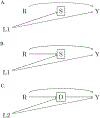Selection Bias in Health Research: Quantifying, Eliminating, or Exacerbating Health Disparities?
- PMID: 38912229
- PMCID: PMC11192540
- DOI: 10.1007/s40471-023-00325-z
Selection Bias in Health Research: Quantifying, Eliminating, or Exacerbating Health Disparities?
Abstract
Purpose of review: To summarize recent literature on selection bias in disparities research addressing either descriptive or causal questions, with examples from dementia research.
Recent findings: Defining a clear estimand, including the target population, is essential to assess whether generalizability bias or collider-stratification bias are threats to inferences. Selection bias in disparities research can result from sampling strategies, differential inclusion pipelines, loss to follow-up, and competing events. If competing events occur, several potentially relevant estimands can be estimated under different assumptions, with different interpretations. The apparent magnitude of a disparity can differ substantially based on the chosen estimand. Both randomized and observational studies may misrepresent health disparities or heterogeneity in treatment effects if they are not based on a known sampling scheme.
Conclusion: Researchers have recently made substantial progress in conceptualization and methods related to selection bias. This progress will improve the relevance of both descriptive and causal health disparities research.
Keywords: collider-stratification bias; competing events; estimands; generalizability; health disparities; selection bias.
Conflict of interest statement
Conflict of Interest: The authors declare no conflict of interest.
Figures

References
-
- Degtiar I, Rose S. A Review of Generalizability and Transportability. Annu Rev Stat Appl. 2023; 10(1):501–524.
-
* Provides and extensive review for addressing external validity, discusses underlying assumptions for generalizability and transportability methods.
-
- Smith LH. Selection Mechanisms and Their Consequences: Understanding and Addressing Selection Bias. Curr Epidemiol Rep. 2020;7:179–89.
-
- Boone SC, le Cessie S, van Dijk KW, de Mutsert R, Mook-Kanamori DO. Avoiding selection bias in metabolomics studies: a tutorial. Metabolomics. 2019;15:7. - PubMed
Grants and funding
LinkOut - more resources
Full Text Sources
Research Materials
